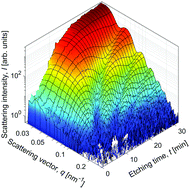Ion track etching of polycarbonate membranes monitored by in situ small angle X-ray scattering†
Abstract
In situ small angle X-ray scattering (SAXS) measurements of ion track etching in polycarbonate foils are used to directly monitor the selective dissolution of ion tracks with high precision, including the early stages of etching. Detailed information about the track etching kinetics and size, shape, and size distribution of an ensemble of nanopores is obtained. Time resolved measurements as a function of temperature and etchant concentration show that the pore radius increases almost linearly with time for all conditions and the etching process can be described by an Arrhenius law. The radial etching shows a power law dependency on the etchant concentration. An increase in the etch rate with increasing temperature or concentration of the etchant reduces the penetration of the etchant into the polymer but does not affect the pore size distribution. The in situ measurements provide an estimate for the track etch rate, which is found to be approximately three orders of magnitude higher than the radial etch rate. The measurement methodology enables new experiments studying membrane fabrication and performance in liquid environments.

- This article is part of the themed collection: 2021 PCCP HOT Articles


 Please wait while we load your content...
Please wait while we load your content...